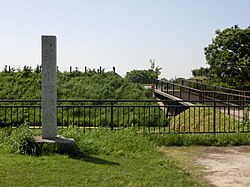Oda Castle
| Oda Castle | |
|---|---|
小田城 | |
Tsukuba, Ibaraki Prefecture, Japan | |
 Oda Castle ruins | |
| Coordinates | 36°9′2″N 140°6′39.2″E / 36.15056°N 140.110889°E |
| Type | hira-style Japanese castle |
| Site information | |
| Open to the public | yes (museum on site) |
| Condition | ruins, partial reconstruction |
| Site history | |
| Built | Kamakura period |
| Built by | Hatta clan |
| In use | Kamakura to Sengoku period |
| Demolished | 1600 |
Oda Castle (小田城, Oda jō) is a hira-style
Background
Oda Castle is located 5 kilometers south of Mount Tsukuba, in southwestern Hitachi Province, overlooking the Sakura River which flows from the northern slope of Mount Tsukuba towards Lake Kasumigaura. Although the surrounding area is a large plain, when the castle was built Lake Kasumigaura extended further inland, and the area surrounding the castle consisted of many smaller rivers and marshes, which divided the territory into numerous defensible islands. Of the many smallholdings in the area, the Oda clan, Hitachi with Oda Castle, was the most powerful. The Oda clan was a cadet branch of the Hatta clan, who were the shugo of Hitachi Province in the Kamakura period.
History
Hotta Tomoie achieved distinction in the campaign against the
Into the
The Satake victory was short-lived, as they were transferred to Dewa Province shortly after the Battle of Sekigahara in 1600 by Tokugawa Ieyasu. Oda Castle was abandoned at that time.[2]
Structure

Oda Castle is located at the foot of Mount Oda and was originally little more than a fortified manor house with a moat and earthen rampart. During the Sengoku period, it was expanded to include a second, third and fourth concentric enclosure, each with an elaborate maze-like system of water moats. The main residence was located between the inner most and second moat, and occupies as rectangular area approximately 120 by 140 meters. Yagura watchtowers were located at the west, east and south corners. The main gate of the castle was to the north, and the clan's bodaiji temple was to the west. In total, the castle measures approximately one kilometer from east to west, and 700 meters north–south.[2]
Current situation
After the
-
Inner Bailey
-
East Kuruwa
-
Nishi-umadashi Kuruwa
-
East Moat
-
Oda Castle Remains History Plaza Information Center
-
Yagura foundation
See also
References
- ^ "小田城跡". Cultural Heritage Online (in Japanese). Agency for Cultural Affairs. Retrieved 25 May 2020.
- ^ ISBN 4311750404.(in Japanese)
Literature
- Schmorleitz, Morton S. (1974). Castles in Japan. Tokyo: Charles E. Tuttle Co. pp. 144–145. ISBN 0-8048-1102-4.
- Motoo, Hinago (1986). Japanese Castles. Tokyo: Kodansha. p. 200 pages. ISBN 0-87011-766-1.
- Mitchelhill, Jennifer (2004). Castles of the Samurai: Power and Beauty. Tokyo: Kodansha. p. 112 pages. ISBN 4-7700-2954-3.
- Turnbull, Stephen (2003). Japanese Castles 1540-1640. Osprey Publishing. p. 64 pages. ISBN 1-84176-429-9.
External links
- Ibaraki Prefectural Board of Education (in Japanese)
- JCastle Info








